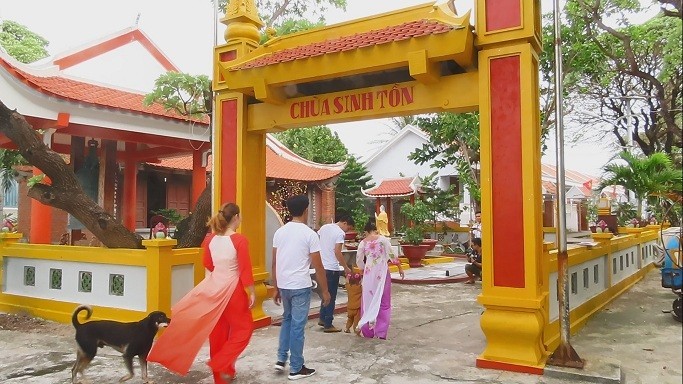
A Vietnamese pagoda sits serenely among the moving seas of Truong Sa
Latest
 |
| Pure Vietnamese architecture of Sinh Ton Pagoda. (Photo: D.N) |
Anyone who comes to the Sinh Ton island, Truong Sa (Spratly) archipelago today can feel the same peace and serenity as the villages on the mainland.
In the middle of the vast sea with waves crashing, next to the houses and rows of shady green trees, standing out among the sun, wind and blue sea is the curved pagoda roof mixed with bright red tiles, along with the quiet space, as if giving strong, lasting vitality to the green island.
As usual, every morning, after cleaning and incense all the worship altars, Master Van Tach, Dharma name Thich Quy Thai, Abbot of Sinh Ton Pagoda, approaches an ancient bronze bell, hanging on the left side of the Pagoda, holding a long round wooden stick, gently but decisively striking the bell.
The sound of the Pagoda bell rang for long periods of time, echoing into the space of the island commune and spreading into the waves and sea in the distance.
Full of emotion, wearing the yellow dress of a monk, Master Thich Quy Thai recounted: "Before going to Truong Sa to carry out the Buddhist mission at Sinh Ton Pagoda, I was quite nervous. However, the first time I stepped foot on Sinh Ton Island and saw the Pagoda, I felt like this place was very close and familiar, like I had been here before."
Just picking up the square almond leaves that had fallen into the Pagoda yard by the gentle wind, Master Thich Quy Thai said: "I feel very honored and proud to be able to work in Buddhism at Sinh Ton Pagoda, on a remote island at the front line of the Fatherland".
According to Master Thich Quy Thai, this sacred pagoda is the only place in the Truong Sa archipelago where a memorial stele is placed to commemorate the 64 soldiers who died in the Gac Ma Battle in 1988. For someone like him who carries the Buddhist mission on his shoulders, it is something special.
On March 14 every year, the pagoda, along with officers, soldiers and people in Sinh Ton island, always organize a ceremony to pay tribute to the heroic martyrs who have fallen for the cause of protecting the sacred sovereignty of the sea and islands of Vietnam. Therefore, the pagoda finds the responsibility of building and protecting Sinh Ton Pagoda even more meaningful.
Sinh Ton Pagoda was built in a traditional architectural style with a structure of one compartment, two wings, and a curved roof. Like other pagodas on the Truong Sa archipelago, the main hall of Sinh Ton Pagoda faces the capital Hanoi with a sacred meaning towards the heart of the country...
Ms. Lu Kim Cuc, a resident of Sinh Ton commune, shared: "On the first and full moon days of every month, we come here to worship at the pagoda. In addition, on the first days of the Solar Year or Lunar New Year, we also go to the pagoda to burn incense and pray for good health for our families, for the soldiers, households on the island and people who go fishing at sea to be safe".
Ms. Cuc said: "Sinh Ton Pagoda is also a fulcrum for fishermen. They often come here to pray for a safe and smooth trip in the sea, providing a source of fresh fish for the island and the mainland.
In addition to praying for peace, we also burn incense to show gratitude to the soldiers who sacrificed their lives and to the soldiers who are in day and night protecting our homeland's sea and islands, giving us a peaceful life on this remote island."
According to her, every weekend, the women on the island spend a day cleaning and sweeping the entire campus inside and outside the pagoda, with the hope of contributing a little effort to build and protect the Pagoda. This is a sacred place of Vietnamese culture.
 |
| Sinh Ton Pagoda is also a symbolic image of spiritual refuge, for people on the island to pray to Buddha. (Photo: Dang Ninh) |
Stationing on Sinh Ton Island, Truong Sa archipelago, Sergeant Do Thanh Long, Battery Commander, a native from Binh Son, Quang Ngai, confided: "I often go to Sinh Ton Pagoda on days off, holidays, Tet, etc. Every time I go to the pagoda, I often burn incense, and especially confide to myself and pray for my family, relatives, comrades, teammates be safe, have good health, have good weather, good wind, and calm sea.".
Sergeant Do Thanh Long shared further: "Being on duty on the sacred island, where the pagoda with the stele commemorating 64 Gac Ma martyrs is located, I personally feel honored, proud and grateful to the generations of predecessors who sacrificed to protect the country, so that we can have peace like today.
I told myself to be determined, to maintain the Party's political ideological stance, to enhance patriotism, to love the Vietnamese people means to love the homeland, to love the sea and islands, be willing to sacrifice to firmly protect sovereignty over the sacred islands and seas of the Fatherland, where the sacred and beloved Sinh Ton Pagoda is located."
In the grounds of Sinh Ton Pagoda, standing out among the bright red curved tiled roofs is the cool green color of maple trees, a typical tree of the Truong Sa archipelago, a tree that still stands tall and strong in the face of harsh winds and waves.
In the midst of the vast sea and sky, occasionally the pagoda bell rings in long, sweet rhythms and then spreads into the air and the sea, acting as a spiritual fulcrum to help every officer, soldier and people here more steadfast, together protect the sea and sky of the Fatherland.









